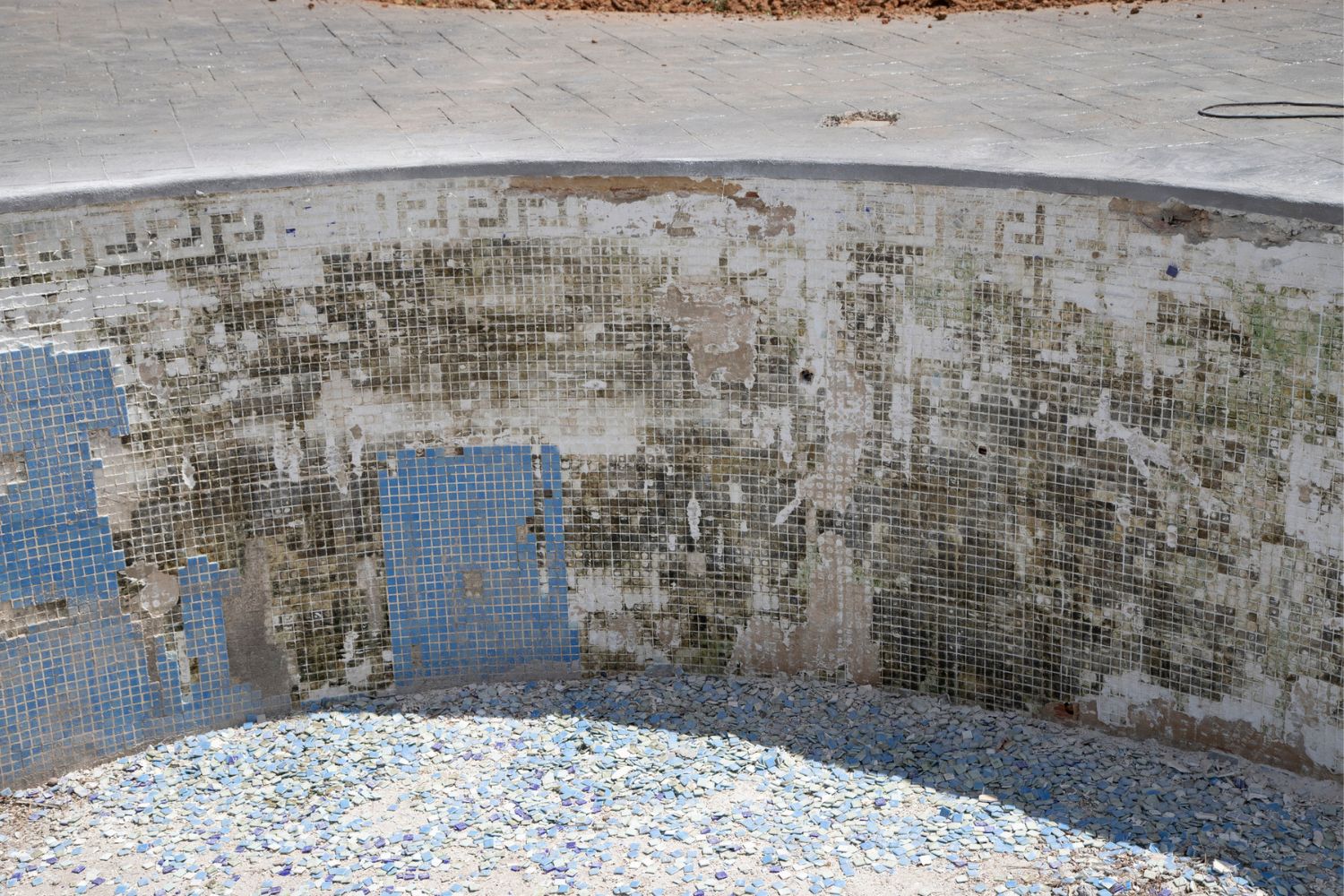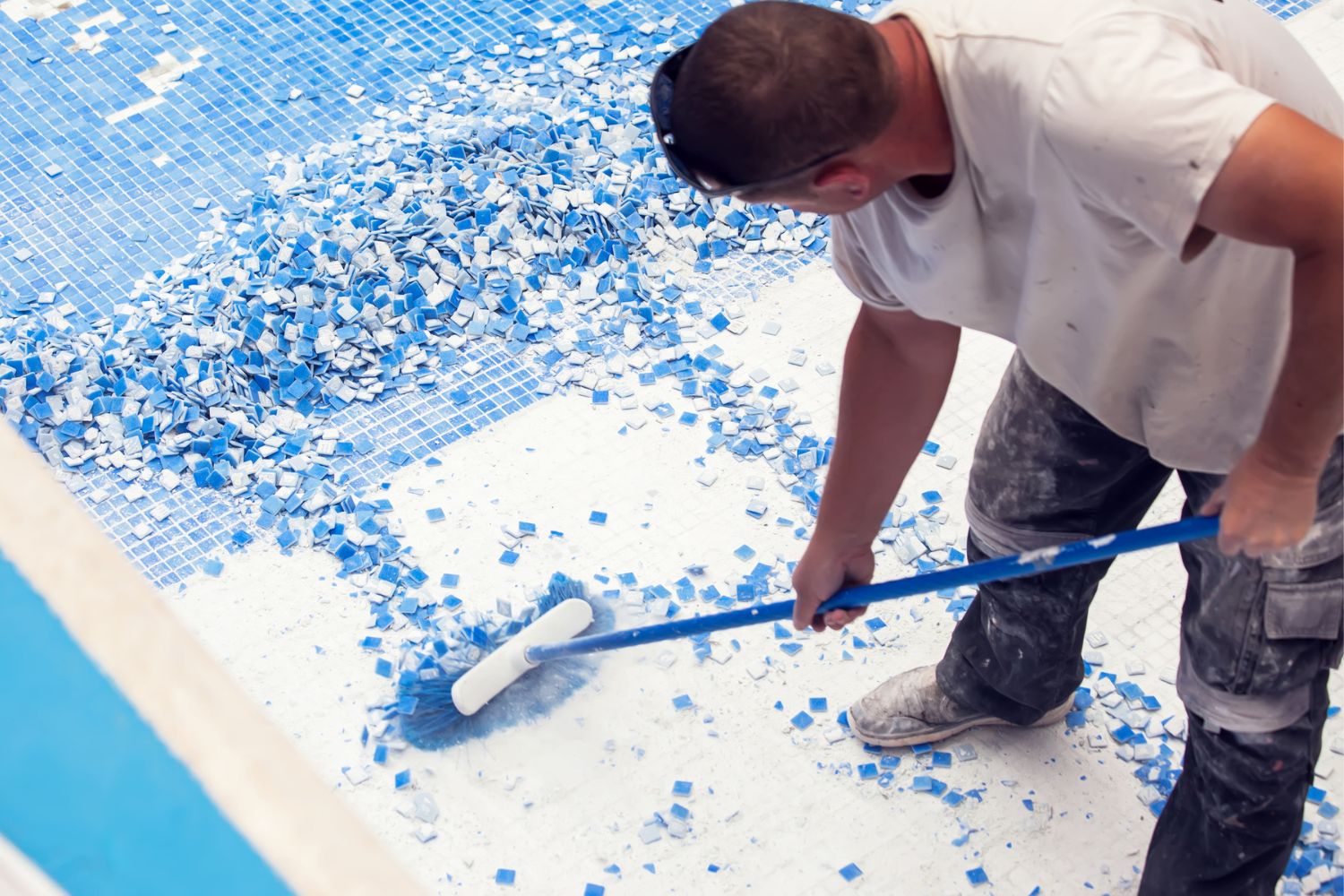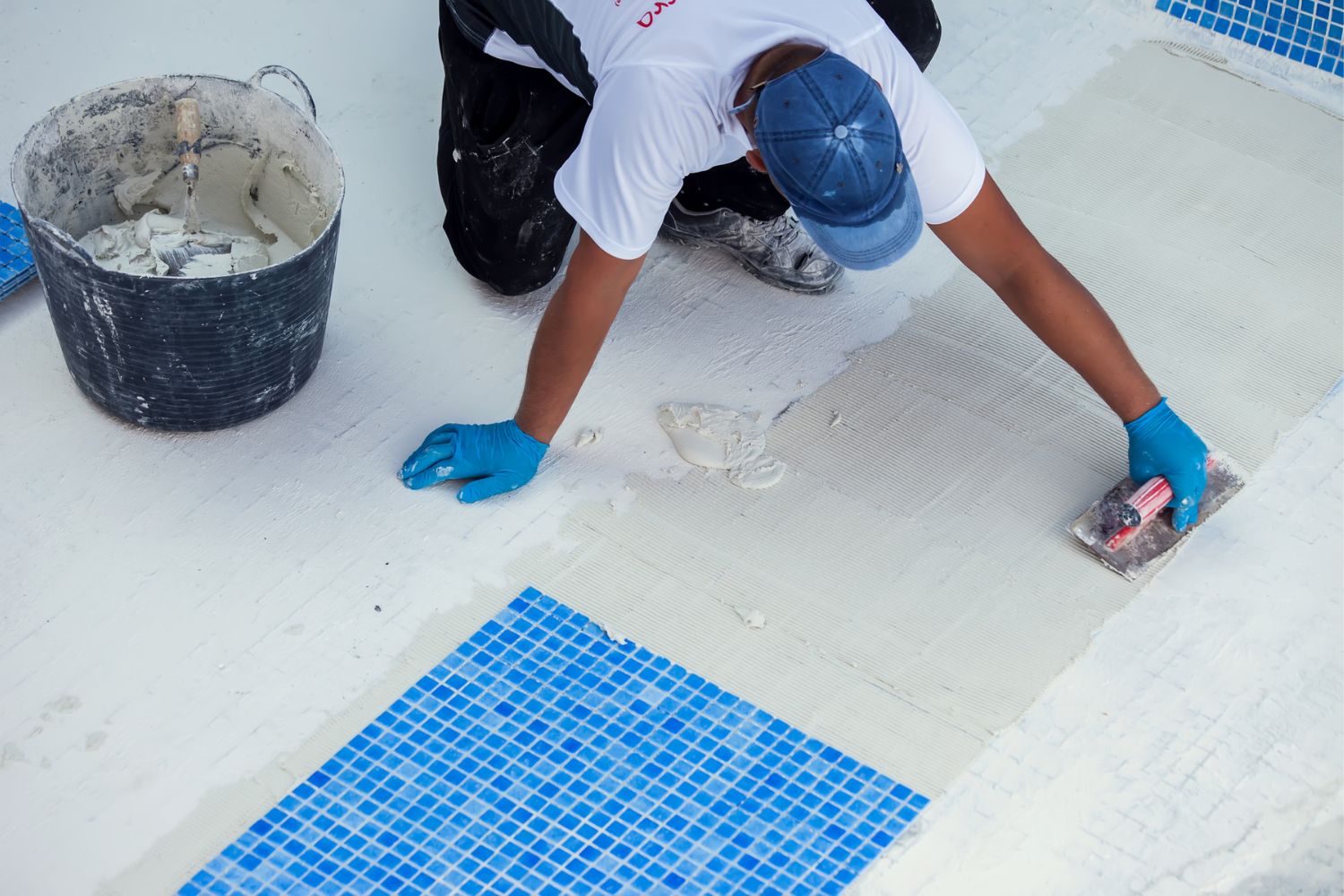

We may earn revenue from the products available on this page and participate in affiliate programs. Learn More ›
- Typical Range: $1,000 to $30,000
- National Average: $6,500
Pool ownership means learning how to maintain your pool, which can include pool resurfacing. In addition to the up-front cost of inground pools or other pool types, pools need resurfacing about every 10 to 12 years, depending on the finishing material. Some telltale signs that a pool needs to be resurfaced are worn spots, rust stains, a rough surface, flaking, peeling, cracks, or discoloration. What is the average cost of pool resurfacing? According to Angi, pool resurfacing cost can range from $1,000 to $30,000; the national average is around $6,500. The average cost to resurface a pool depends on a few factors, including pool type, pool size, surface condition, what repairs are needed, and the type of finish. Finishes can range from paint to plaster to aggregate to tile, with pricing that can run the gamut from $1,500 per 1,000 square feet to $30,000 per 1,000 square feet. Here, we’ll break down the items that affect a pool resurface cost estimate, additional costs and considerations, and frequently asked questions regarding pool resurfacing cost.
Factors in Calculating Pool Resurfacing Cost
How much does pool resurfacing cost? That depends on several factors. Prices can differ from the national average due to pool size and type, pool material, pool condition, finish type, draining and refilling costs, cleaning costs, labor, and geographic location.
Pool Size and Type
Typically, the bigger the pool, the more expensive it will be to resurface it. The average resurfacing pool cost is $6,500 per 1,000 square feet. The overall project costs can fluctuate depending on what type of finish is used and the pool type. Fiberglass and concrete pools cost the most to resurface and although vinyl pools technically cannot be resurfaced, the liner can be replaced.
Pool Material
Both fiberglass and concrete pools cost $6,500 per 1,000 square feet to resurface, but the price can increase significantly based on the type of material and finish. Fiberglass pools can be resurfaced using paint, tile, and aggregate, while homeowners can choose from paint, plaster, aggregate, or tile for concrete pools. Vinyl pools cannot be resurfaced but the entire liner can be replaced, which typically costs between $1,000 and $3,500 per 1,000 square feet.

Pool Condition
If the pool is in bad condition, repairs will be needed before any resurfacing can take place. If the surface has rust stains or cracks that result in leaking, a pool resurfacing professional will require that repairs are made prior to resurfacing.
Finish Type
There are a few finishes to choose from when resurfacing a pool. These can range from budget-friendly paint finishes to high-end glass tiles.
- Paint. The cost to paint a pool is about $1,500 per 1,000 square feet, including labor costs. This finish doesn’t have a high-end look, and it typically lasts between 2 and 5 years before it will need to be repainted. Epoxy pool paint can last about 7 years, but any type of pool paint is prone to damage from unbalanced chemical levels.
- Plaster. Resurfacing a pool with plaster typically costs $5,500 per 1,000 square feet. Correctly installed high-quality plaster can last 10 years before the pool will need to be replastered. While white is the standard color of pool plaster, some pool resurfacing professionals may have the option to add color to the plaster for a custom hue. The most popular plaster colors are gray, blue, and black. Keep in mind that adding pigments to plaster will result in an additional charge.
- Aggregate. Both smooth and rough aggregate finishes are available in pebble, crushed stone, and quartz. This long-lasting finish costs about $6,500 per 1,000 square feet, including labor. A quartz pool finish can last about 12 years, while a glass-bead finish can last 20 years or more.
- Tile. Resurfacing an entire pool in tile is an expensive project that can top out at $30,000 per 1,000 square feet. Many homeowners choose to tile above the waterline and opt for a less-expensive option below the water for a more cost-effective high-end look. Porcelain tiles typically cost $4 per square foot, ceramic tiles are $6 per square foot, and glass tiles are the most expensive at $25 per square foot. These prices do not include labor, which usually ranges from $45 to $65 per hour. This labor-intensive process of resurfacing a pool with tiles is the most expensive option, but tiles last the longest of any finish—about 20 years—and glass tiles last even longer.
Draining and Refilling
In order to resurface a pool, it first needs to be drained. Draining a pool can cost from $175 to $225. Refilling a pool can run approximately $55 per 5,000 gallons of water. All of these additional costs can affect a resurface pool cost estimate.
Cleaning
A pool needs to be thoroughly cleaned before the resurfacing process can begin. A pool professional can charge about $250 to clean a pool. Replastering a concrete pool also involves an acid wash before the refinishing.
Labor
Labor costs can vary, but they usually range between $45 and $65 per hour, depending on the complexity of the job and the finish material.
Geographic Location
Pool resurfacing costs can differ from the national average because of geographic location. In some densely populated urban areas, labor and material costs can be more expensive than in more rural locations.

Additional Costs and Considerations
When answering the question, “How much does resurfacing a pool cost?” it’s important to consider any additional costs and considerations that can affect the overall price. These can include repair costs and pool customizations.
Repairs
Before resurfacing, any repairs to the pool will need to be made. If there are cracks and leaks, the source of the leak will need to be determined and repaired or it can further damage the resurfacing finish. If plaster needs to be patched or tile needs to be replaced, this can add to the grand total of the project.
Customizations
Certain resurfacing finishes are customizable, and homeowners can choose a look that goes with their home and backyard aesthetic. Aggregate finishes can allow for custom designs, and homeowners can choose to add pigment to plaster to achieve gray, blue, or black hues. Tile colors and patterns can be used to create designs that are unique to a pool.
Resurfacing Costs by Pool Type
How much to get a pool resurfaced? That depends on the type of pool. Each pool type has distinct options for resurfacing, different materials, and labor costs.
Fiberglass
Fiberglass pools are coated in a layer of gelcoat. Over time, this layer breaks down and will crack, discolor, and blister. Since the gelcoat can’t be applied in a backyard setting, other resurfacing options are available. If a fiberglass pool has a few minor dents and scratches, resurfacing with pool paint is a cost-effective way to go. Pool paint costs about $1 per square foot, or $1,500 per 1,000 square feet, including labor. Resurfacing an entire fiberglass pool costs about $6,500 per 1,000 square feet, depending on the resurfacing material. Aggregate finishes, such as pebble, crushed stone, or quartz can last between 10 and 20 years. A tile surface can last for much longer but is also more expensive. Since the cost to install a fiberglass pool can be higher than other types of pools, keeping it maintained and resurfacing when needed can save money on pool replacement.
Concrete or Gunite
Depending on the resurfacing finish, concrete or gunite pools cost about $6,500 per 1,000 square feet to resurface. Keep in mind that finishes that take more time to install will be more expensive, and the cost of materials can easily add up. Painting would be the cheapest option, and plastering a concrete or gunite pool typically runs between $3 and $5 per square foot, depending on customizations. Plaster typically lasts about 10 years before it will need to be resurfaced and the more expensive options, such as aggregate or tile, last even longer.
Vinyl
The cost of above-ground pools and inground pools lined with vinyl can be lower than other pool types, making them popular with homeowners since they’re a budget-friendly option. Technically, vinyl pools cannot be resurfaced, but the liner can be replaced. A new vinyl liner ranges from $1,000 to $3,500 per 1,000 square feet.

Do I Need Pool Resurfacing?
If your pool is looking tired and has chips, cracks, stains, or a rough surface, chances are it needs to be resurfaced. The average cost to resurface a pool’s walls and floor depends on the type of pool and the resurfacing material. Here are a few telltale signs that it’s time to resurface a pool.
Flaking or Peeling
If the plaster in a concrete or gunite pool is peeling or flaking, it’s time to resurface it. Known as spalling, this peeling and flaking regularly occurs around the edges of the floor or on the steps. This is usually the result of low calcium or pH levels in the water. The only solution is resurfacing.
Chips or Cracks
Any chips or cracks in a pool surface need to be repaired as soon as possible. If the pool is leaking, then the source of the leak needs to be found before any resurfacing can begin.
Visible Leaks
If the water level isn’t as consistent as it used to be, there may be a leak in the pool. If the soil shifts, it may cause the pool to crack and leak. Any visible leaks need to be addressed and repaired to prevent further damage to the pool.
Staining or Discoloration
Surface stains caused by salt, copper, and calcium are common in pools and appear on the walls as a bluish-gray color. Rust stains from the tie wire or rebar in the pool shell will only get larger over time. Resurfacing the entire pool is the only way to get a consistent, stain-free look for the pool surface.
Rough Texture
The pool surface can become rough due to the plaster wearing thin, the presence of calcium deposits, or the plaster breaking down from chemical imbalances in the water. If the surface is uncomfortable to walk or sit on, it’s time to resurface the pool.

Pool Resurfacing: DIY vs. Hiring a Professional
Although there are DIY kits for pool resurfacing, many of them are intended for small repairs or replastering a compact area. Pool professionals recommend leaving resurfacing projects to trained and experienced technicians. Making a mistake when applying resurfacing materials can result in additional costs to fix the problem. While it may be tempting to save the $45 to $65 per hour for labor costs, pool resurfacing is best left to the professionals.
How to Save Money on Pool Resurfacing Cost
Budgeting for pool resurfacing costs can be tricky, and the additional fees associated with the project can quickly add up. Here are a few ways to save money without compromising on the features you want.
- Get at least three estimates. Getting multiple resurfacing estimates from the best pool installation companies in your area can help you find the best price for your budget.
- Do some of the work yourself. Taking care of the draining, cleaning, refilling, and chemicals on your own can help save money.
- Use accent tiling. If you like the look of a tiled pool but the cost to resurface the entire pool with tile is out of your price range, opt for using tile above the waterline. The underwater part of the pool can be resurfaced with a more budget-friendly material.
- Opt for vinyl. A vinyl pool has a less expensive up-front cost, and it is more economical when the time comes to replace the liner when compared to resurfacing a fiberglass or concrete pool.

Questions to Ask About Pool Resurfacing
Before deciding on what pool resurfacing options are the best for you, it’s helpful to have vital information regarding resurfacing to make the best decisions. Asking the right questions can help avoid miscommunication and find the right professional for the job.
- Are you licensed and insured?
- Will you provide references?
- Are you a member of the Association of Pool and Spa Professionals (APSP)?
- How much does it cost to resurface a swimming pool?
- Who will resurface the pool?
- How long will the project take?
- What guarantees or warranties do you offer?
- Where can I leave a review of your work?
FAQs
Deciding on pool resurfacing and keeping the overall costs budget-friendly can be a daunting process. Here are some frequently asked questions about pool resurfacing to help homeowners find the best professional for the job.
Q. How much do pool plaster repairs cost?
The average cost to replaster an inground pool ranges from $4 to $7 per square foot.
Q. How much does it cost to resurface a pool deck?
Resurfacing a pool deck is a different process than resurfacing a pool. If the deck needs a concrete overlay, it can run from $3,000 to $4,000, but if the deck needs to be stained and cutouts made for a more decorative look, it can cost between $5,000 and $6,000.
Q. How often should I replaster my pool?
A pool should be replastered about every 10 years, depending on condition and maintenance. If the pool shows signs that it needs to be resurfaced before 10 years, it should be done then.
Q. How do I know when my pool needs to be resurfaced?
A pool shows signs when it needs to be resurfaced, such as peeling, stains, chips, cracks, roughness, discoloration, paint failure, or other defects in the surface. If these signs are ignored, they can develop into more expensive repairs and can even cause health issues or injuries.
Q. How do I calculate how much pool plaster I need?
To find how much plaster is needed for resurfacing, measure each side of the pool in feet and add them together to get the total. If the pool isn’t rectangular, measure to get a rough estimate. To get an accurate measurement, a pool resurfacing professional should measure your pool. This will result in a more accurate quote, depending on the resurfacing material.
Q. What happens if I don’t replaster my pool?
When a pool is left in disrepair, it can cause an array of problems, such as leaks, bacteria growth, waterborne diseases, injury, and an unappealing pool. Pool maintenance costs are fairly low and can save you money in the long run.
Sources: Angi, Thumbtack, Layorcare, Venture Custom Pools
